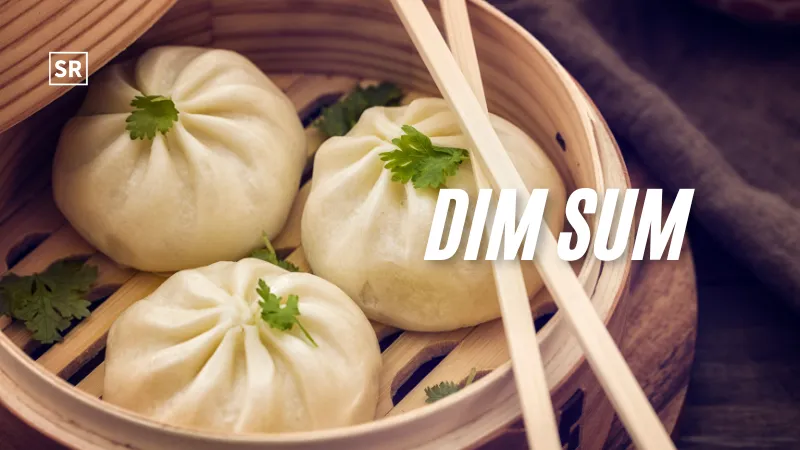
Dim sum is a traditional Chinese meal made up of many small dishes served with tea. It started in southern China, especially in Hong Kong and Guangdong, and has now become popular all over the world. The word “dim sum” means “touch the heart.” In the past, these dishes were made as light snacks to enjoy with tea not as full meals.
Today, dim sum is a bigger meal that people usually eat in the morning or early afternoon, like a brunch. It’s often shared with family or friends. There are many kinds of dim sum — such as steamed dumplings with shrimp or pork (har gow and siu mai), soft buns filled with barbecue pork (char siu bao), crispy spring rolls, and sweet desserts like egg tarts.
Dim sum dishes are served in small bamboo baskets or on tiny plates, so everyone can try many different foods in one meal. In some traditional restaurants, servers push carts filled with dim sum from table to table, and guests choose what they want. This makes eating dim sum a fun and social experience — full of sharing, talking, and enjoying tasty food together.
The Origin and History of Dim Sum
The history of dim sum goes back hundreds of years to ancient China. It began along the Silk Road where travelers would stop at tea houses to rest. These tea houses started serving small snacks with tea to help travelers relax and regain energy. Over time, these small dishes became known as dim sum. The idea of enjoying tea with food is called “yum cha,” which means “drinking tea.”
Dim sum became very popular in southern China, especially in the Guangdong (Canton) region and in Hong Kong. Chefs there began making many different kinds of small dishes, both savory and sweet. What started as simple snacks gradually turned into a beloved dining tradition often enjoyed by families and friends on weekends or during special occasions.
Each dim sum dish was made to be small and easy to eat in one or two bites, allowing people to taste many different flavors in one meal. As Chinese people moved to other parts of the world they brought this tradition with them. Today, dim sum restaurants can be found in many countries, keeping the centuries-old culture of tea and small dishes alive for everyone to enjoy.
Popular Dim Sum Dishes You Must Try
A traditional dim sum meal includes many delicious dishes, each with its own special flavor and texture. Some of the most popular ones are dumplings, such as har gow (shrimp dumplings) and siu mai (pork and shrimp dumplings). These are steamed in small bamboo baskets, making them soft, juicy, and full of flavor.
Another favorite is char siu bao a fluffy white bun filled with sweet and savory barbecue pork. It’s one of the most loved dim sum dishes and is enjoyed by both children and adults. The soft texture and rich filling make it a perfect comfort food.
There are also spring rolls, which are crispy rolls filled with vegetables or meat, and cheong fun, smooth rice noodle rolls often filled with shrimp, beef or pork and served with a light soy sauce. For those who like something crunchy, there are fried snacks like sesame balls filled with sweet red bean paste or taro puffs, which are crispy on the outside and soft inside.
Dim sum also includes sweet dishes such as egg tarts, which have a flaky crust and creamy custard filling. Most dim sum dishes are small and easy to share, allowing everyone at the table to taste many different items. This variety of flavors, textures, and aromas makes eating dim sum a joyful and social experience.
How do you order dim sum?
Ordering dim sum is simple and fun, especially in traditional Chinese restaurants. Dim sum comes in many small dishes so that you can try a variety of foods in one meal.
In some restaurants, servers push carts with dim sum around the dining area. You can pick the dishes you want as the carts pass by your table. In other restaurants, you can order from a menu by marking the dishes you like.
People usually start with savory dishes like dumplings or buns, then try fried items, rice rolls, or noodles. Many also finish the meal with sweet desserts, such as egg tarts or sesame balls.
Dim sum is meant to be shared, so it’s good to order several dishes for the table. Don’t forget to drink tea with your meal, as this is an important part of the tradition called yum cha. Take your time, taste different flavors, and enjoy eating together with family or friends.
Conclusion
Dim sum is more than just a meal — it is a special tradition that brings together food, tea, and people. It started as small snacks served along the Silk Road and has grown into a meal with many different dishes. From savory dumplings and soft buns to crispy rolls and sweet desserts, dim sum lets everyone taste many flavors and textures in one sitting. Sharing dim sum encourages talking, laughter, and spending time with family and friends, making it about much more than just eating.
Drinking tea with dim sum, called yum cha, is an important part of the experience, helping people relax and enjoy their meal. Today, dim sum is popular all over the world not just in southern China and Hong Kong. Whether you are trying it for the first time or enjoying it regularly, dim sum combines history, delicious food, and social fun, making every meal enjoyable, memorable, and full of warmth.
FAQs
What is dim sum?
Dim sum is a traditional Chinese meal made up of many small dishes served with tea. It includes savory items like dumplings and buns, as well as sweet treats like egg tarts.
When is dim sum usually eaten?
Dim sum is usually eaten in the morning or early afternoon, similar to brunch.
What are some popular dim sum dishes?
Some popular dishes include shrimp dumplings (har gow), pork dumplings (siu mai), barbecue pork buns (char siu bao), spring rolls, rice noodle rolls (cheong fun), sesame balls, taro puffs, and egg tarts.





